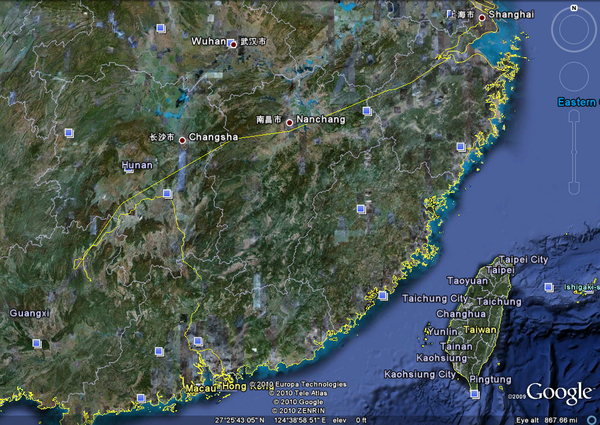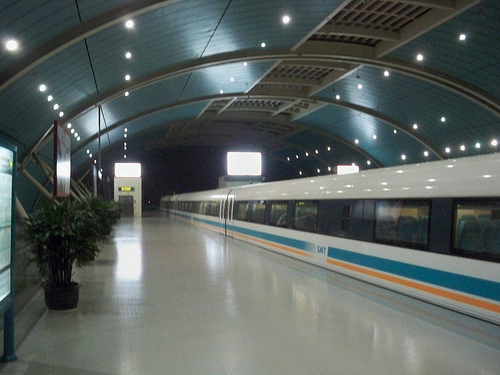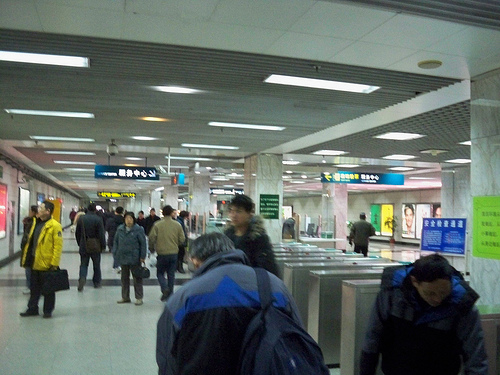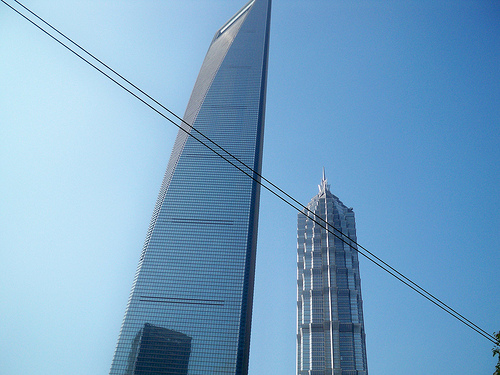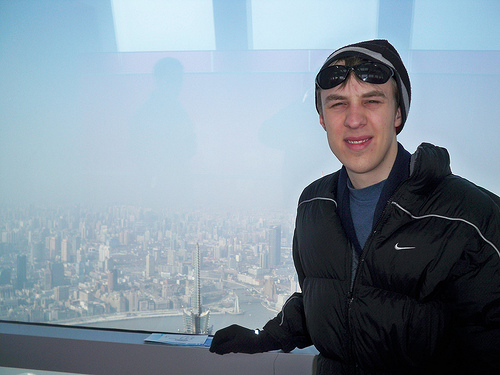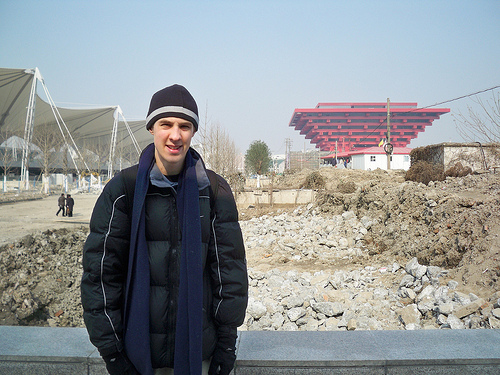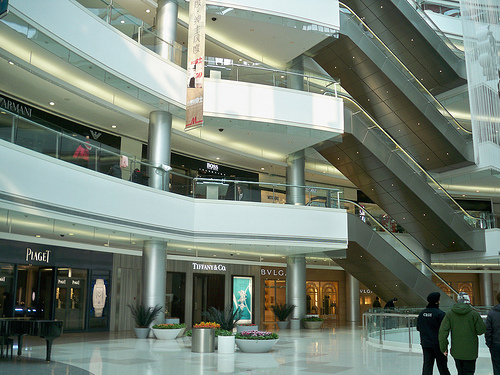Difference between revisions of "China Post Trip Impressions"
From ThePlaz.com
(post 1st draft) |
(add pics) |
||
| Line 1: | Line 1: | ||
1/25/2010 Personal Update: Back from China | 1/25/2010 Personal Update: Back from China | ||
| − | I am somewhere over the Sea of Okhotsk, off the coast of Russia, traveling at 33200ft traveling back home from China. At home, it is 4:09 AM. In China, it’s 5:09PM. I was in China as part of an MIT class, 6.A53, Entrepreneurship and China. We | + | I am somewhere over the Sea of Okhotsk, off the coast of Russia, traveling at 33200ft traveling back home from China. At home, it is 4:09 AM. In China, it’s 5:09PM. I was in China as part of an MIT class, 6.A53, Entrepreneurship and China. We traveled through Shanghai, Hangzhou, Guilin, Yangzhou, Shenzhen, and Hong Kong. Along the way we visited companies, universities, and entrepreneurs. We also saw the sights of China and participated in the MAD 2010 Asia conference. It was a high paced tour of China’s customs and business. I don’t know where to start in recounting the trip. |
| − | + | [[:File:China Trip.kmz|Google Earth file of trip]] | |
| + | [[File:Map of MIT China Trip.png|600px]] | ||
| − | + | Taken with [[Amod GPS Logger]] | |
| − | There are signs for the expo everywhere. I really hope to get to go. I think it will be one of the last big ones as they are expensive with little direct benefit. | + | The trip started on January 1st. to Shanghai. There were a lot of families traveling back home on the airplane. Shanghai is the world’s largest city, and it sprawls out since it is not contained by anything like Manhattan or Hong Kong. We took their $1.2 billion USD maglev ride. It was cool, but it did not really go too far. Also the maglev did not have good English. That was a recurring theme in China, even official tourist sites don't have good English. |
| + | |||
| + | [[File:Maglev in Station.jpg]] | ||
| + | |||
| + | We then got on their metro system. The system is all very new, all the stations look the same, and it is expanding with a line opening every month or so. This is so incredible. In the US a city is considered transit friendly if it opens a new line every decade! | ||
| + | |||
| + | [[File:Chinas Metro System.jpg]] | ||
| + | |||
| + | On one day, we visited the [http://en.wikipedia.org/wiki/Shanghai_World_Financial_Center Shanghai World Financial Center], one of the world’s tallest building. So apparently that title is very contentious with what counts as a building and what is included in the height count. Wikipedia says it is the third tallest building in the world, but the highest occupied floor, the highest height to roof, and the highest observation deck. We were their a day before the [http://en.wikipedia.org/wiki/Burj_Khalifa Burj Khalifa] opened and took some of the title of highest occupied floor and highest height to roof. | ||
| + | |||
| + | [[File:SWFC.jpg]] | ||
| + | [[File:On top of SWFC.jpg]] | ||
| + | |||
| + | There are signs for the expo everywhere. I really hope to get to go. I think it will be one of the last big ones as they are expensive with little direct benefit. We had an hour one morning, so we visited the construction site. | ||
| + | |||
| + | [[File:Expo Construction Site.jpg]] | ||
| + | |||
| + | Where we were was a very wealthy area. It was a home for the newly wealthy Chinese to enjoy conspicuous consumption, American style. In addition, there were a lot of hawkers. You could could buy a fake Rolex only a few feet from a luxury store selling legitimate ones. | ||
| + | |||
| + | [[File:Plaza 66.jpg]] | ||
| − | |||
It was very cold when we were in China, around 0C. Due [http://www.tochinaandbeyond.com/wordpress/2009/12/no-heat/ to an old law], buildings below the Yangtze River cannot have heaters. Almost all of the homes have these very [http://aecb.net/PDFs/green%20electricity%20illusion.pdf inefficient] “air conditioners” which have electric heaters in them. Dorms rooms actually do not have heat, and one school requires students to go to another building for water or showers. I would not last long at all in those conditions. But I will no longer complain that my 65F dorm room is cold. | It was very cold when we were in China, around 0C. Due [http://www.tochinaandbeyond.com/wordpress/2009/12/no-heat/ to an old law], buildings below the Yangtze River cannot have heaters. Almost all of the homes have these very [http://aecb.net/PDFs/green%20electricity%20illusion.pdf inefficient] “air conditioners” which have electric heaters in them. Dorms rooms actually do not have heat, and one school requires students to go to another building for water or showers. I would not last long at all in those conditions. But I will no longer complain that my 65F dorm room is cold. | ||
Revision as of 19:01, 28 January 2010
1/25/2010 Personal Update: Back from China
I am somewhere over the Sea of Okhotsk, off the coast of Russia, traveling at 33200ft traveling back home from China. At home, it is 4:09 AM. In China, it’s 5:09PM. I was in China as part of an MIT class, 6.A53, Entrepreneurship and China. We traveled through Shanghai, Hangzhou, Guilin, Yangzhou, Shenzhen, and Hong Kong. Along the way we visited companies, universities, and entrepreneurs. We also saw the sights of China and participated in the MAD 2010 Asia conference. It was a high paced tour of China’s customs and business. I don’t know where to start in recounting the trip.
Taken with Amod GPS Logger
The trip started on January 1st. to Shanghai. There were a lot of families traveling back home on the airplane. Shanghai is the world’s largest city, and it sprawls out since it is not contained by anything like Manhattan or Hong Kong. We took their $1.2 billion USD maglev ride. It was cool, but it did not really go too far. Also the maglev did not have good English. That was a recurring theme in China, even official tourist sites don't have good English.
We then got on their metro system. The system is all very new, all the stations look the same, and it is expanding with a line opening every month or so. This is so incredible. In the US a city is considered transit friendly if it opens a new line every decade!
On one day, we visited the Shanghai World Financial Center, one of the world’s tallest building. So apparently that title is very contentious with what counts as a building and what is included in the height count. Wikipedia says it is the third tallest building in the world, but the highest occupied floor, the highest height to roof, and the highest observation deck. We were their a day before the Burj Khalifa opened and took some of the title of highest occupied floor and highest height to roof.
There are signs for the expo everywhere. I really hope to get to go. I think it will be one of the last big ones as they are expensive with little direct benefit. We had an hour one morning, so we visited the construction site.
Where we were was a very wealthy area. It was a home for the newly wealthy Chinese to enjoy conspicuous consumption, American style. In addition, there were a lot of hawkers. You could could buy a fake Rolex only a few feet from a luxury store selling legitimate ones.
It was very cold when we were in China, around 0C. Due to an old law, buildings below the Yangtze River cannot have heaters. Almost all of the homes have these very inefficient “air conditioners” which have electric heaters in them. Dorms rooms actually do not have heat, and one school requires students to go to another building for water or showers. I would not last long at all in those conditions. But I will no longer complain that my 65F dorm room is cold.
Entrance to universities in China is by entrance exam. U students: be diplomatic, eng, not creativity, learning eng, very competitive, this is the culture, research more It is very hard for a Chinese student to break out and stand out. They had to work very hard to get to the top-tier university in China. Only a few can go to an American graduate school, let along MIT. After that, they have to find a company willing to sponsor their work visa. One of these universities serves more meals in minute than MIT does all night. It is also far lower cost. One meal is about $7 RMB, or 1 USD, while MIT struggles to make money off $7 USD meals. Granted, it looks like a prison cafeteria, and the food is mass produced, but it will be hard to compete with.
Cisco has set up an R&D center in China with about 1,500 people. They told us that they did that as a pre-condition for being able to sell to the Chinese government and state-owned telcos. It does look like they invested a lot of money into the center. The people we saw seemed to be doing testing – for operations and temperature. I got the feeling that the center would be very good at doing the rudimentary testing and engineering, which Americans would find too boring. The Chinese are also very proud to be doing entry-level engineering work for an American firm.
We visited two large factories, one produced bags and the other produced clothes. One had a city of about 12,000 people. Both worked for many well-known US brands. The cost of the product is about 1/5 of retail cost. Both were run by Hong Kong owners and managers. The company with the large city had a 300 room “hotel” for its managers. The workers make a little more than $1,000 RMB a month (about $150 USD).
These factories are successful because of the nearly endless stream of China’s 1.3 billion people into the city looking to take any job they can. Southern China at $1000 RMB/month is actually too expensive; many factories are moving up north where labor is only about $500 RMB/month. Remember the cost of living is far, far lower. From what we saw, the workers seemed OK with the work. They want to work more and earn overtime. For them it’s better than the farm where they made nothing on plots the size of an Olympic-sized swimming pool. People’s quality of life is improving, but for a lot of people, it has a long way to go.
All of the buildings, including the subway, use this granite. I suppose it makes the building look fancy, but it is very annoying. It is everywhere in China, and I think it makes the buildings feel cool and inhospitable. The worst part is when it rains. Depending on how it is cut, it can be very slippery.
I liked the town of Yungsho very much. It was a very outdoorsy-tourist town, like the Jersey Shore. That means that the town does not have bug luxury hotels and stores, only moderate priced ones and not many chains. They said that before most of the visitors were western, not now it is 80% Chinese. The town exists for the wonderful landscape that you can see with rafting down the river in a Bamboo raft, or riding a bike.
We took a sleeper train from Guilen to Shenzen. It was the first time I had taken a sleeper train, and I enjoyed the experience. China’s railroads have very little scenery around as you go by. The train station in Shanghai was very nice and big. I was supproised at how many people were in there. They also have more of a process where you wait in a waiting room and when you exit, you take a separate path. The trains were also all full, even the CRH (China Rail Highspeed). In the west the train system is used mostly by business travelers, and is far more expensive. In China, everyone travels by rail. The high-speed system is not much more money even.
When you cross the border into Hong Kong, it feels very different. It just seems cleaner and more modern, including the customs building. 95% of the signs are in English as well, and they use good English. The place has more history and they don’t use that granite tile everywhere. The tradeoff is that the buildings are older and smaller. Our hotel room was very small. Over the border in Shenzhen we had four times the space for the same cost.
A professor said that not many Hong Kong graduates are interested in Entrepreneurship. Instead, all want to work for the many international firms that have their offices there. The government and some universities in Hong Kong are trying to change that. They held a conference to inspire people to make a difference by themselves called MAD. Compared to China, Hong Kong also has more citizen activists. For example, students were protesting against a high speed rail line. However, the Hong Kong citizens have not been exposed to as much entrepreneurship training as students in the United States have. The conference had about half its speakers from the United States and about half local Hong Kong residents giving their experience.
Over the trip, I read both Superfusion and China Inc. Both were written before the current recession. Superfusion’s thesis was that the United States and China’s economy have become, without much notice, intertwined and inseparable. An idea that I agree with, but can be described with far fewer words. I enjoyed China Inc. much more. It recounted this history of China and then smoothly jumped from topic to topic. It explained much of what I was seeing and experiencing myself in China.
I believe that in the future, pure manufacturing and engineering jobs will continue to leave the country, much to the protest of unions whose artificially high wages and benefits are coming crashing down. The US still has the lead in creative enterprises. As the Recession Generation article from Newsweek points out, the US will be faced with a world where credit may not be as easy as it was in 2008 and where more people are facing a comfortable standard of living around the world. I disagree with the assessment made in the article that hard work no longer pays off in America. I think that all of the hours I have put in have led to my admission to MIT and my selection to go on this trip. Entrepreneurship and advancement in a company are still tied to hard work. Americans cannot grow up and be entitled to a job. There is too much competition from worldwide.
I took over 5,300 photos and videos. They are on Flickr. Most are geotagged. Link and map
